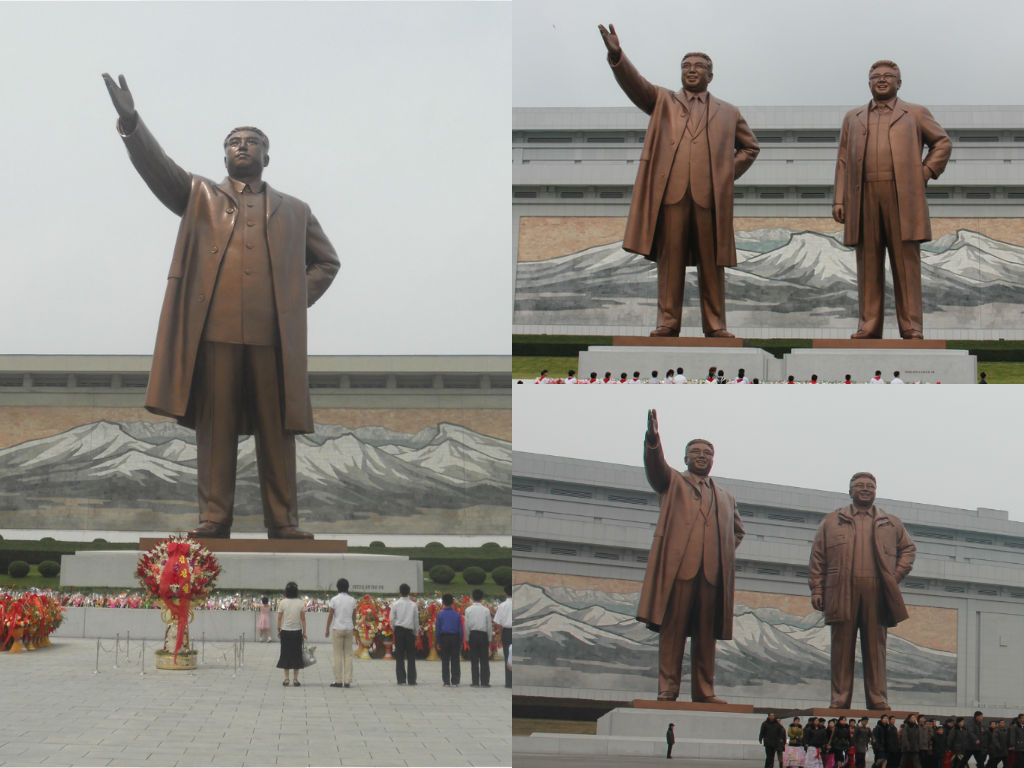Mansu Hill Grand Monument on:
[Wikipedia]
[Google]
[Amazon]
The Mansu Hill Grand Monument (
 Behind the central statues is a wall of the Korean Revolution Museum building, displaying a mosaic mural showing a scene from
Behind the central statues is a wall of the Korean Revolution Museum building, displaying a mosaic mural showing a scene from
Chosŏn'gŭl
The Korean alphabet, known as Hangul, . Hangul may also be written as following South Korea's standard Romanization. ( ) in South Korea and Chosŏn'gŭl in North Korea, is the modern official writing system for the Korean language. The let ...
: 만수대대기념비; Hanja
Hanja (Hangul: ; Hanja: , ), alternatively known as Hancha, are Chinese characters () used in the writing of Korean. Hanja was used as early as the Gojoseon period, the first ever Korean kingdom.
(, ) refers to Sino-Korean vocabulary, ...
: 萬壽臺大紀念碑) is a complex of monuments in Pyongyang
Pyongyang (, , ) is the capital and largest city of North Korea, where it is known as the "Capital of the Revolution". Pyongyang is located on the Taedong River about upstream from its mouth on the Yellow Sea. According to the 2008 populat ...
, North Korea
North Korea, officially the Democratic People's Republic of Korea (DPRK), is a country in East Asia. It constitutes the northern half of the Korean Peninsula and shares borders with China and Russia to the north, at the Yalu (Amnok) and T ...
. There are 229 figures in all, commemorating the history of the revolutionary struggle of the Korean people, and especially their leaders. The central part of the monument consists of two bronze statues
A statue is a free-standing sculpture in which the realistic, full-length figures of persons or animals are carved or cast in a durable material such as wood, metal or stone. Typical statues are life-sized or close to life-size; a sculpture t ...
of Kim Il-sung
Kim Il-sung (; , ; born Kim Song-ju, ; 15 April 1912 – 8 July 1994) was a North Korean politician and the founder of North Korea, which he ruled from the country's establishment in 1948 until his death in 1994. He held the posts of ...
and Kim Jong-il.
History
The monument was originally dedicated in April 1972 in honor of Kim Il Sung's 60th birthday. At the time, the monument featured only Kim Il-sung. The statue was originally covered in gold leaf, but was later altered to bronze. Following Kim Jong-il's death in 2011, a similar statue of him was erected on the north side of Kim Il-sung. At the same time, Kim Il-sung's statue was altered to portray him at a later age and smiling. Kim Il-sung's originalMao suit
The modern Chinese tunic suit is a style of male attire originally known in China as the Zhongshan suit () after the republican leader Sun Yat-sen (Sun Zhongshan). Sun Yat-sen introduced the style shortly after the founding of the Republic of ...
was also replaced as Western-style suit. The statue of Kim Jong-il initially featured a long coat but it was promptly changed to his signature parka
A parka or anorak is a type of coat with a hood, often lined with fur or faux fur. This kind of garment is a staple of Inuit clothing, traditionally made from caribou or seal skin, for hunting and kayaking in the frigid Arctic. Some Inuit ...
. South Korean sources have estimated the cost of the additional statue at $10 million, with North Korean workers working overseas being ordered to donate $150 each towards the monument.
Description
 Behind the central statues is a wall of the Korean Revolution Museum building, displaying a mosaic mural showing a scene from
Behind the central statues is a wall of the Korean Revolution Museum building, displaying a mosaic mural showing a scene from Mount Paektu
Paektu Mountain (), also known as Baekdu Mountain and in China as Changbai Mountain ( zh, s=长白山, t=長白山; Manchu: Golmin Šanggiyan Alin), is an active stratovolcano on the Chinese–North Korean border. At , it is the highest moun ...
, considered to be the sacred mountain of revolution. On either side of the statues, leading away from the building, are two monuments consisting of statues of different soldiers, workers, and farmers in their anti-Japanese revolutionary struggle and socialist revolution. The long line of human figures depicted on them are on average 5 meters tall.
An official North Korean website describes it thus:
All visitors to the site, both locals and foreigners, are expected to bow and leave flowers in order to show respect. Photos of the statues are permitted, but the photos must capture the statues in their entirety.
References
External links
* Monuments and memorials in North Korea Buildings and structures in Pyongyang Tourist attractions in Pyongyang Statues of heads of government Outdoor sculptures in North Korea Statues of presidents Statues in North Korea 1972 establishments in North Korea 1972 sculptures Colossal statues {{NorthKorea-struct-stub